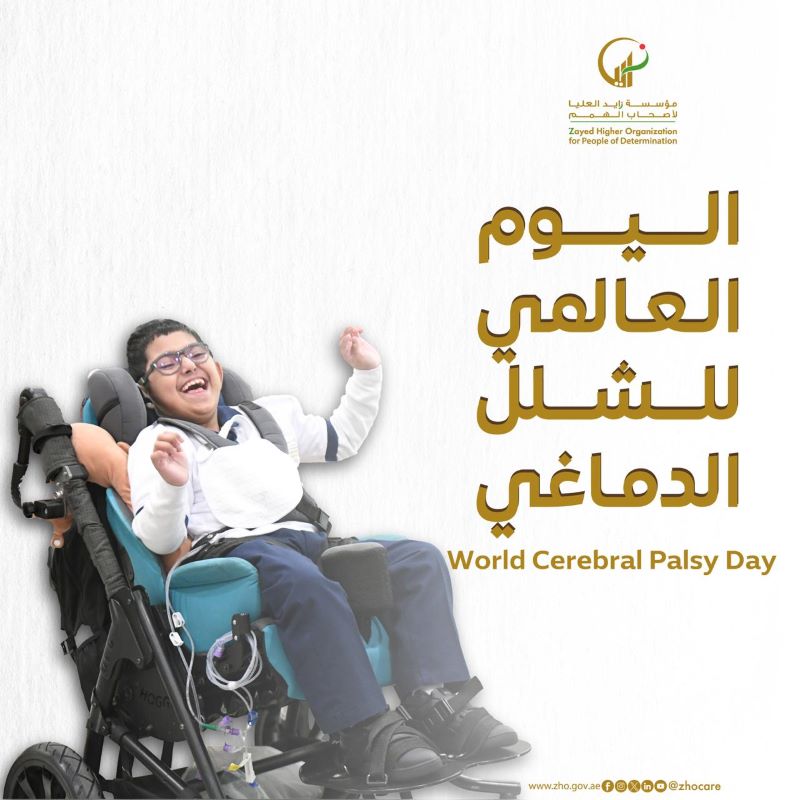أبوظبي
In conjunction with World Cerebral Palsy Day, which falls on October 6th every year, aiming to raise awareness and show solidarity with individuals with cerebral palsy, as well as to highlight their health, educational, psychological, social, and rehabilitative rights, Zayed Higher Organization for People of Determination emphasized the importance of raising awareness about this disability

In conjunction with World Cerebral Palsy Day, which falls on October 6th every year, aiming to raise awareness and show solidarity with individuals with cerebral palsy, as well as to highlight their health, educational, psychological, social, and rehabilitative rights, Zayed Higher Organization for People of Determination emphasized the importance of raising awareness about this disability. The organization also stressed the importance of educating the public about the causes and prevention methods, showcasing the abilities of its students with cerebral palsy, and providing guidance to various media outlets to highlight the basic health, educational, psychological, social, economic, and rehabilitative rights of people with cerebral palsy.
His Excellency Abdullah Abdul-Ali Al Humaidan, Secretary-General of the organization, confirmed that the organization is committed to enhancing the lives of individuals from various categories of People of Determination, particularly those with cerebral palsy. He emphasized the importance of raising awareness about them, how to interact with them, and enabling them to play an active and positive role in the comprehensive and sustainable social and economic development process. This is achieved by applying the latest global theories and innovative initiatives for their rehabilitation in accordance with the highest international standards, using the best care and rehabilitation programs applied in developed countries, and adopting them in all care and rehabilitation centers affiliated with the organization.
He emphasized the significance of World Cerebral Palsy Day in raising awareness of the challenges faced by individuals with cerebral palsy and the importance of providing them with necessary support. He stated, "We will continue to make every effort to further develop the services provided to those under our care, including individuals with cerebral palsy, focusing on their rehabilitation and training. We will also benefit from the experiences of advanced countries in this field to ensure that the members of our organization receive world-class care services. Additionally, we strive to provide suitable employment opportunities for them, harnessing their potential, and working towards their empowerment and inclusion in society."
Cerebral palsy affects more than 17 million people worldwide. It is a medical term that refers to a group of motor problems associated with a lack of muscle control, uncoordinated movement, posture, and balance. It results from damage to the brain's movement control areas during its development or due to incomplete development of these areas during pregnancy. The affected parts of the brain will not heal, nor will the condition worsen. Improvement in a child’s movement, balance, and posture depends mainly on how early treatment begins, its continuity, the extent of the injury, and its severity. Studies estimate that the prevalence of cerebral palsy ranges between 1 to 6 children per 1,000 live births, and to date, studies have not proven a genetic link to cerebral palsy.
Types of cerebral palsy include spastic cerebral palsy, ataxic cerebral palsy, dyskinetic cerebral palsy, and mixed cerebral palsy. The causes of cerebral palsy vary, and they can be categorized into pre-birth causes, birth-related causes, and post-birth causes. Pre-birth causes include viral infections that may affect the mother in the first months of pregnancy, such as rubella, uncontrolled diabetes, or high blood pressure. Birth-related causes include brain damage due to very premature birth, difficult labor, prolonged pregnancy, delayed breathing at birth, or jaundice. Post-birth causes include viral infections of the brain, such as meningitis, head injuries, high fever, or dehydration.
Studies indicate that advances in medical imaging technology have enabled doctors to visualize the brain and capture various activities, such as through CT scans, which highlight brain tissue in different colors depending on tissue density. This allows doctors to detect inflammation, tumors, or structural abnormalities. MRI scans also enable visualization of bone marrow and parts of the brain's cortex. Additionally, cerebral angiography helps identify problems in blood vessels that supply the brain, alongside laboratory tests such as blood and urine tests, and other essential medical procedures.
Page Last Update: 07 October 2024
